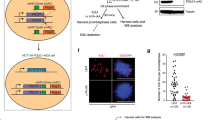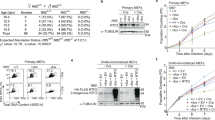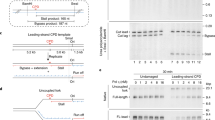Abstract
Hydroxyurea reduces DNA replication by nucleotide deprivation, whereas UV damage generates DNA photoproducts that directly block replication fork progression. We show that the low fidelity class Y polymerase Pol η is recruited to proliferating cell nuclear antigen at replication forks both by hydroxyurea and UV light. Under nucleotide deprivation, Pol η allows cells to accumulate at the G1/S boundary by facilitating slow S-phase progression and promotes apoptosis. Normal cells consequently enter apoptosis at a faster rate than Pol η-deficient cells. Coincident with hydroxyurea-induced S-phase delay, Pol η-deficient cells undergo more replication fork breakage and accumulate more foci of the Mre11/Rad50/Nbs1 complex and phosphorylated histone H2AX. We conclude that under conditions of nucleotide deprivation, Pol η is required for S-phase progression but is proapoptotic. However, as Pol η is reported to require higher nucleotide concentrations than class B replicative polymerases, its recruitment by hydroxyurea requires it to function under suboptimal conditions. Our results suggest that hydroxyurea-induced apoptosis occurs at the G1/S boundary and that initiation of the S-phase requires greater nucleotide concentrations than does S-phase progression.
This is a preview of subscription content, access via your institution
Access options
Subscribe to this journal
Receive 50 print issues and online access
$259.00 per year
only $5.18 per issue
Buy this article
- Purchase on Springer Link
- Instant access to full article PDF
Prices may be subject to local taxes which are calculated during checkout







Similar content being viewed by others
References
Arnaudeau C, Lundin C, Helleday T . (2001). DNA double-strand breaks associated with replication forks are predominantly repaired by homologous recombination involving an exchange mechanism in mammalian cells. J Mol Biol 307: 1235–1245.
Arnaudeau C, Tenorio Miranda E, Jenssen D, Helleday T . (2000). Inhibition of DNA synthesis is a potent mechanism by which cytostatic drugs induce homologous recombination in mammalian cells. Mutat Res 461: 221–228.
Bartkova J, Rezaei N, Liontos M, Karakaidos P, Kletsas D, Issaeva N et al. (2006). Oncogene-induced senescence is part of the tumorigenesis barrier imposed by DNA damage checkpoints. Nature 444: 633–637.
Broughton BC, Cordonnier A, Kleijer WJ, Jaspers NG, Fawcett H, Raams A et al. (2002). Molecular analysis of mutations in DNA polymerase eta in xeroderma pigmentosum-variant patients. Proc Natl Acad Sci U S A. 99: 815–820.
Burgers PM, Koonin EV, Bruford E, Blanco L, Burtis KC, Christman MF et al. (2001). Eukaryotic DNA polymerases: proposal for a revised nomenclature. J. Biological Chemistry 276: 43487–43490.
Carter GL, Thompson DP, Cory JG . (1989). Mechanisms of drug resistance to inhibitors directed at the individual subunits of ribonucleotide reductase. Cancer Commun 1: 13–20.
Cleaver JE, Afzal V, Feeney L, McDowell M, Sadinski W, Volpe JPG et al. (1999). Increased UV sensitivity and chromosomal instability related to p53 function in the xeroderma pigmentosum variant. Cancer Res 59: 1102–1108.
Cleaver JE, Bartholomew J, Char S, Crowley E, Feeney L, Limoli CL . (2002). Polymerase η and p53 jointly regulate cell survival, apoptosis and Mre11 recombination during S-phase checkpoint arrest after UV irradiation. DNA Repair 3: 1–17.
Cordeiro-stone M, Makhov AM, Zaritskaya LS, Griffith JD . (1999). Analysis of DNA replication forks encountering a pyrimidine dimer in the template to the leading strand. J Mol Biol 289: 1207–1218.
Cordonnier AM, Lehmann AR, Fuchs RP . (1999). Impaired translesion synthesis in xeroderma pigmentosum variant extracts. Mol Cell Biol 19: 2206–2211.
Feijoo C, Hall-Jackson C, Wu R, Jenkins D, Leitch J, Gilbert DM et al. (2001). Activation of mammalian Chk1 during DNA replication arrest: a role for Chk1 in the intra-S-phase checkpoint monitoring replication origin firing. J Cell Biol 154: 913–923.
Furuta T, Takemura H, Liao ZY, Aune GJ, Redon C, Sedelnikova OA et al. (2003). Phosphorylation of histone H2AX and activation of Mre11, Rad50, and Nbs1 in response to replication-dependent DNA-double-strand breaks induced by mammalian DNA topoisomerase I cleavage complexes. J Biol Chem 278: 20303–20312.
Godov VG, Jarosz DF, Walker FL, Simmons LA, Walker GC . (2006). Y-family DNA polymerases respond to DNA damage-independent inhibition of replication fork progression. EMBO J 25: 868–879.
Halicka HD, Huang X, Traganos F, King MA, Dai W, Darzynkiewicz Z . (2005). Histone H2AX phosphorylation after cell irradiation with UV-B: relationship to cell cycle phase and induction of apoptosis. Cell Cycle 4: 339–345.
Hammond EM, Green SL, Giaccia AJ . (2003). Comparison of hypoxia-induced replication arrest with hydroxyurea and aphidicolin-induced arrest. Mutat Res 532: 205–213.
Huang TT, Nijman SM, Mirchandani KD, Galardy PJ, Cohn MA, Haas W et al. (2006). Regulation of monoubiquitinated PCNA by DUB autocleavage. Nat Cell Biol 8: 339–347.
Hurta RA, Wright JA . (1990). Amplification of the genes for both components of ribonucleotide reductase in hydroxyurea resistant mammalian cells. Biochem Biophys Res Commun 28: 258–264.
Johnson RE, Kondratick CM, Prakash S, Prakash L . (1999). hRAD30 mutations in the variant form of xeroderma pigmentosum. Science 264: 263–265.
Kannouche P, Broughton BC, Volker M, Hanaoka F, Mullenders LH, Lehmann AR . (2001). Domain structure, localization, and function of DNA polymerase eta, defective in xeroderma pigmentosum variant cells. Genes Dev 15: 158–172.
Kurose A, Tanaka T, Huang X, Traganos F, Dai W, Darzynkiewicz Z . (2006a). Effects of hydroxyurea and aphidicolin on phosphorylation of ataxia telangiectasia mutated on Ser 1981 and histone H2AX on Ser 139 in relation to cell cycle phase and induction of apoptosis. Cytometry A 69: 212–221.
Kurose A, Tanaka T, Huang X, Traganos F, Darzynkiewicz Z . (2006b). Synchronization in the cell cycle by inhibitors of DNA replication induces histone H2AX phosphorylation: an indication of DNA damage. Cell Prolif 39: 231–240.
Limoli CL, Giedzinski E, Bonner WM, Cleaver JE . (2002a). UV-induced replication arrest in the xeroderma pigmentosum variant leads to double strand breaks, γ-H2Ax formation, and Mre11 relocalization. Proc Natl Acad Sci USA 99: 233–238.
Limoli CL, Giedzinski E, Cleaver JE . (2005). Alternative recombination pathways in UV-irradiated XP Variant cells. Oncogene 24: 3708–3714.
Limoli CL, Giedzinski E, Morgan WF, Cleaver JE . (2000). Polymerase η deficiency in the XP variant uncovers an overlap between the S-phase checkpoint and double strand break repair. Proc Nat Acad Sci USA 97: 7939–7946.
Limoli CL, Laposa R, Cleaver JE . (2002b). DNA Replication arrest in XP Variant cells after UV exposure is diverted into an Mre11-dependent recombination pathway by the kinase inhibitor Wortmannin. Mutat Res 510: 121–129.
Lowndes NF, Toh GW-L . (2005). DNA repair: the importance of phosphorylating histone H2AX. Curr Biol 15: R99–R102.
Lu C, Zhu F, Cho YY, Tang F, Zykova T, Ma WY et al. (2006). Cell apoptosis: requirement of H2AX in DNA ladder formation, but not for the activation of caspase-3. Mol Cell 23: 121–132.
Marti TM, Hefner E, Feeney L, Natale V, Cleaver JE . (2006). H2AX phosphorylation within the G1 phase after UV irradiation depends on nucleotide excision repair and not DNA double strand breaks. Proc Natl Acad Sci USA 103: 9891–9896.
Masutani C, Kusumoto R, Yamada A, Dohmae N, Yokol M, Yuasa M et al. (1999). The XPV (xeroderma pigmentosum variant) gene encodes human DNA polymerase η. Nature 399: 700–704.
Mukherjee B, Kessinger C, Kobayashi J, Chen BP, Chen DJ, Chatterjee A et al. (2006). DNA-PK phosphorylates H2AX during apoptotic DNA fragmentation in mammalian cells. DNA Repair 5: 575–590.
O'Driscoll M, Ruiz-Perez VL, Woods CG, Jeggo PA, Goodship JA . (2003). A splicing mutation affecting expression of ataxia-telangiectasis and Rad 3-related protein (ATR) results in Seckel syndrome. Nat Genet 33: 497–501.
Ogi T, Kannouche P, Lehmann AR . (2005). Localisation of human Y-family DNA polymerase kappa: relationship to PCNA foci. 118 (Partt 1): 129–136.
Rappold I, Iwabuchi K, Date T, Chen J . (2001). Tumor suppressor p53 binding protein 1 (53BP1) is involved in DNA damage-signaling pathways. J Cell Biol 153: 613–620.
Robison JG, Elliott J, Dixon K, Oakley GG . (2004). Replication protein A and the Mre11.Rad50.Nbs1 complex co-localize and interact at sites of stalled replication forks. J Biol Chem 279: 34802–34810.
Saintigny Y, Delacote F, Vares G, Petitot F, Lambert S, Averbeck D et al. (2001). Characterization of homologous recombination induced by replication inhibition in mammalian cells. EMBO J 20: 3861–3870.
Thakur M, Wernick M, Collins C, Limoli C, Crowley E, Cleaver JE . (2001). DNA polymerase η undergoes alternative splicing, protects against UV sensitivity and apoptosis, and suppresses Mre11-dependent recombination. Genes Chromosomes Cancer 32: 222–235.
Ward IM, Chen J . (2001). Histone H2AX is phosphorylated in an ATR-dependent manner in response to replicational stress. J Biol Chem 276: 47759–47762.
Washington MT, Johnson RE, Prakash L, Prakash S . (2003). The mechanism of nucleotide incorporation by human polymerase eta differs from that of the yeast enzyme. Mol Cell Biol 23: 8316–8322.
Zhao H, Piwnica-Worms H . (2001). ATR-mediated checkpoint pathways regulate phosphorylation and activation of human Chk1. Mol Cell Biol 21: 4129–4139.
Acknowledgements
The work described here was supported by an NIEHS Grant 1 RO1 ES 8061 and an NINDS Grant 5R01NS052781 (to JEC) and American Cancer Society RSG-00-036-04-CNE (to CLL). We are also grateful to the XP Society, Poughkeepsie, NY, for their continued support and encouragement to one of us (JEC). Dr D Karentz conducted this work while on sabbatical with additional support from the Lily Drake Cancer Research Fund from the University of San Francisco. We are also grateful to the Molecular Diagnostics Core, UCSF Cancer Center for assistance in immunofluorescence.
Author information
Authors and Affiliations
Corresponding author
Rights and permissions
About this article
Cite this article
de Feraudy, S., Limoli, C., Giedzinski, E. et al. Pol η is required for DNA replication during nucleotide deprivation by hydroxyurea. Oncogene 26, 5713–5721 (2007). https://doi.org/10.1038/sj.onc.1210385
Received:
Revised:
Accepted:
Published:
Issue Date:
DOI: https://doi.org/10.1038/sj.onc.1210385



